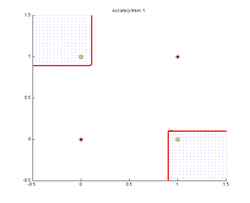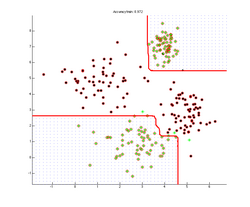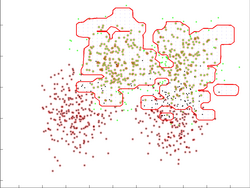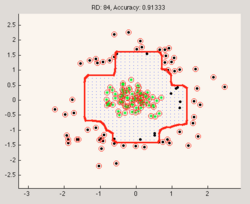Diferencia entre revisiones de «Relevance Dendritic Computing: codes and examples»
De Grupo de Inteligencia Computacional (GIC)
Sin resumen de edición |
Sin resumen de edición |
||
| (No se muestran 13 ediciones intermedias de otro usuario) | |||
| Línea 1: | Línea 1: | ||
This page is devoted to publishing code for Relevance Dendritic Computing and some execution examples. | This page is devoted to publishing code for Relevance Dendritic Computing and some execution examples. | ||
Download the MATLAB code for Relevance Dendritic Computing here: | :Download the MATLAB code for Relevance Dendritic Computing here: | ||
:[[Media:SLKN_code.zip | SLKN code ]] | |||
:[[Media:SBL_SLKN_code.zip | SBL-SLKN code ]] | |||
Datasets | :Datasets avalaible in: | ||
:[[http://www.raetschlab.org/Members/raetsch/benchmark/?searchterm=benchmark | Benchmarks datasets]] | |||
:In figures shown some results obtained, in this case, the distribution of class 1 (blue dot region) obtained by training on the (a) XOR, (b) Gaussians centered at the XOR points, (c) the synthetic data used by Tipping and (d) synthetic ring data. | |||
<div align="center">[[Imagen:RDC6_xor.png | 250px]] (a) [[Imagen:RDC6_gauss_xor.png | 250px]] (b) </div> | |||
<div align="center">[[Imagen:RDC-synth.png | 250px]] (c) [[Imagen:SLKN_ring.png | 250px]] (d) </div> | |||
: The details of the method are given in the paper | |||
''Learning Parsimonious Dendritic Classifiers'' | |||
M. Graña, and A.I. Gonzalez, Neurocomputing (submitted for publication). | |||
'''Copyright 2011 Grupo Inteligencia Computacional, Universidad del País Vasco / Euskal Herriko Unibertsitatea (UPV/EHU)'''. | |||
Revisión actual - 09:25 22 may 2013
This page is devoted to publishing code for Relevance Dendritic Computing and some execution examples.
- Download the MATLAB code for Relevance Dendritic Computing here:
- SLKN code
- SBL-SLKN code
- Datasets avalaible in:
- [| Benchmarks datasets]
- In figures shown some results obtained, in this case, the distribution of class 1 (blue dot region) obtained by training on the (a) XOR, (b) Gaussians centered at the XOR points, (c) the synthetic data used by Tipping and (d) synthetic ring data.
- The details of the method are given in the paper
Learning Parsimonious Dendritic Classifiers M. Graña, and A.I. Gonzalez, Neurocomputing (submitted for publication).
Copyright 2011 Grupo Inteligencia Computacional, Universidad del País Vasco / Euskal Herriko Unibertsitatea (UPV/EHU).



